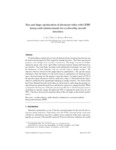Size and shape optimization of aluminum tubes with GFRP honeycomb reinforcements for crashworthy aircraft structures

Use este enlace para citar
http://hdl.handle.net/2183/21644Colecciones
- Investigación (ETSECCP) [826]
Metadatos
Mostrar el registro completo del ítemTítulo
Size and shape optimization of aluminum tubes with GFRP honeycomb reinforcements for crashworthy aircraft structuresFecha
2015Cita bibliográfica
Paz, J., Díaz, J., Romera, L., & Costas, M. (2015). Size and shape optimization of aluminum tubes with GFRP honeycomb reinforcements for crashworthy aircraft structures. Composite Structures, 133, 499–507.
Resumen
[Abstract:] Crashworthiness optimization of aircraft and automotive structures has become one the main research targets for their respective leading industries. The following research proposes a new design of an aircraft’s vertical strut. The design consists of a hollow aluminum square tube with a glass-fiber reinforced polymer honeycomb-shaped inner structure. Size and shape surrogate-based optimization techniques are used, with the thicknesses of both materials, cell size and cell shape as design variables. The objective function chosen for the single-objective optimization is the specific energy absorption, while the metrics for the multi-objective optimization are the peak force, mass, absorbed energy and the specific energy absorption. An improvement of 22% of the specific energy absorption with low peak force values is obtained from the single-objective optimization by significantly changing all design variables. Two Pareto fronts have been obtained from the multi-objective optimization confronting, the specific energy absorption against the peak force and the mass against the energy absorbed. When compared to the baseline model, the optimized models show substantial improvement, increasing the specific energy absorption by 65% or reducing the peak force by over 55%. It has been observed an important effect of the cell shape on the model’s performance.
Palabras clave
Crashworthiness
Multi-objective optimization
Surrogate methods
Honeycomb structure
GFRP
Multi-objective optimization
Surrogate methods
Honeycomb structure
GFRP





